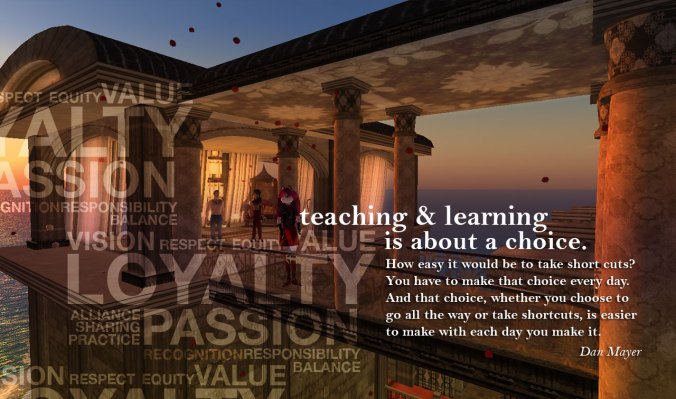Dan Mayer asks ‘How easy would it be to take short cuts’. I read this a while ago, tracked back from Chris Lehmann, and its something that during a discussion today, that kept ringing in my head as the conversation was laced with conflicting pressures over loyalty and responsibility.
I work at an extraordinary school, doing extraordinary things with learning – in extraordinary times.
I think that the choices I’ve made in being part of that have been the right ones – most of the time. Anyone making hard choices knows self-doubt, trepidation and fear – yet you make them anyway.
There is a huge personal, spiritual and emotional cost involved, from the first time you question yourself as a teacher and realise that we are actually at the beginning of learning again.
The challenges kids face today are infinately more complex than even 5 years ago, trying to identify these, and find solutions – in a system that isn’t intended to allow you to do that is hard.
Seeing the efforts of others – is a constant ‘energy recharge’ – that those making the easy choices are unaware. There is a spirit of co-operation that transcends culture, geography, religion and wealth. From the most underfunded comes advice to the most affluent and visa versa. Conversation is the currency, and students are the investment houses. The recharge outlet is called Twitter, Skype, Gtalk, Google Reader and Second Life. We hear and see things that makes us believe that it is possible through the fractured conversations in the metaverse – despite our localised reality.
Within the confusion of our present culture, we are faced with opportunities the like of which we haven’t known. And I believe that our present ‘crisis’ has a lot to do with the fire and water through which we must go if we are to grasp those opportunities and make the most of them. This is of course just one of many situations where the global community is struggling with the question of the local option – and where, of course, multiple ambiguities can be found which muddle up the moral dilemmas.
One of the phrases and tactics used in advertising to get the maximum out of workers used to be – “if we don’t get this done, then we’ll loose the client”. That mentality still strikes me as ridiculous. Firstly, the was rarely a ‘we’ – as they mean ‘you’, and secondly, the client was never ‘yours’ but theres. There was never an ‘all for one and one for all’ bargain between us.
There are multiple reasons that something could or could not get done – and often quite beyond the control of the poor sap that was being told it. I heard it a hundred times, but never saw a client walk because some designer didn’t knock out that logo colour variant by 4pm.
I think its the same is schools. School will go on regardless of one person. Its not one persons school – but the sum of all the passion, effort (or lack of) between all the participants. If there’s one thing that I feel administrators need to do – above everything else – if find out who is making the hard choices – like Dan Mayer – and if what he’s doing, is something that you want – then for goodness sake – also look at how he’s doing it and don’t try to apply 20th Century Management Strategies to demand or retain that. That won’t build the capacity needed to get from ‘storming’ to ‘norming’.
Time served is is not the most essential criteria to make judgements on teachers pay or conditions – if you are talking about 21C schools, and I think one of the biggest challenges to the way school systems are operated. If time served was the secret to success, then how come all those experienced, institutional executives just wiped out trillions of dollars of the world economy. Anything is possible it seems, but change starts with a choice. I made mine.
